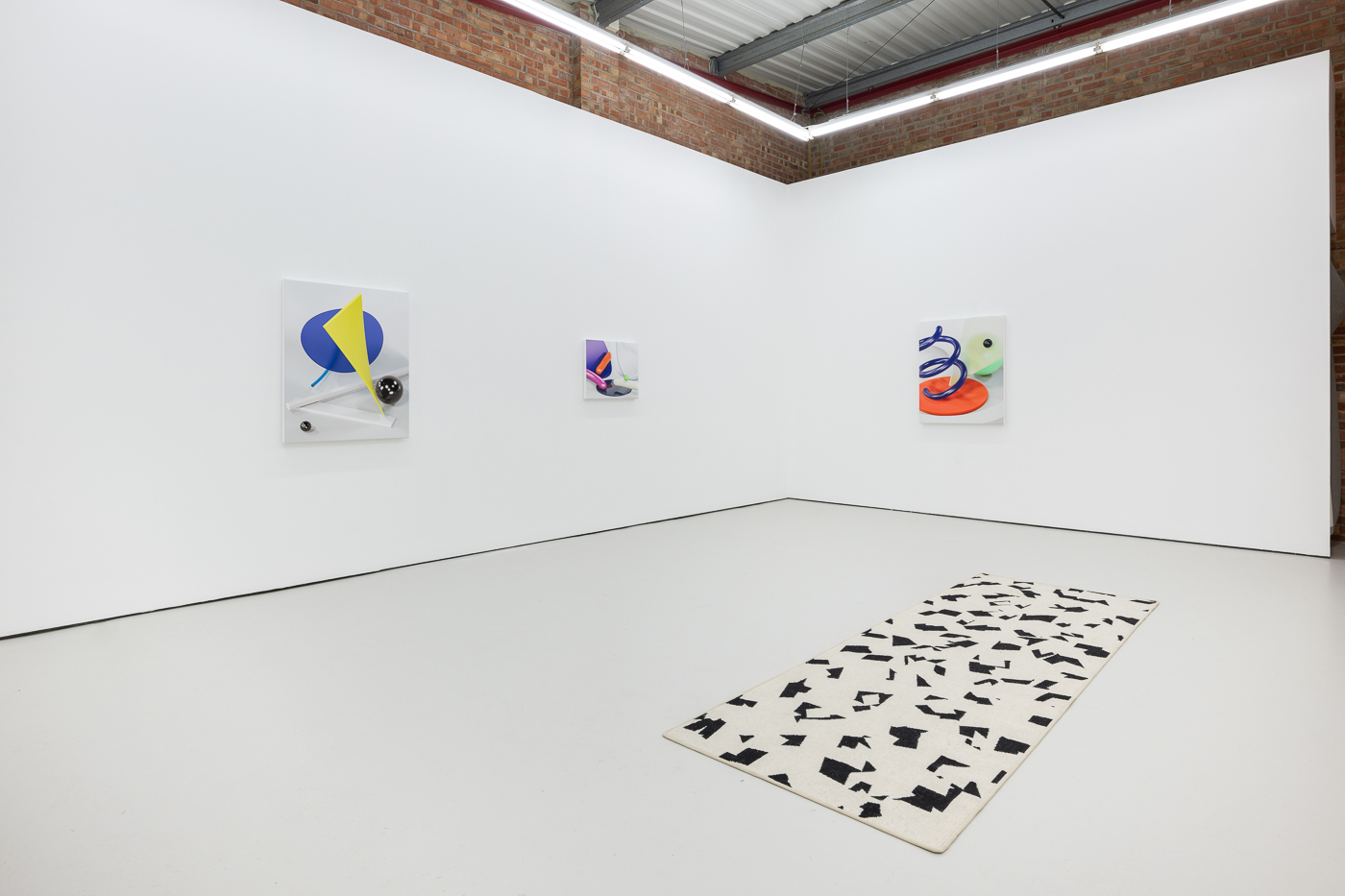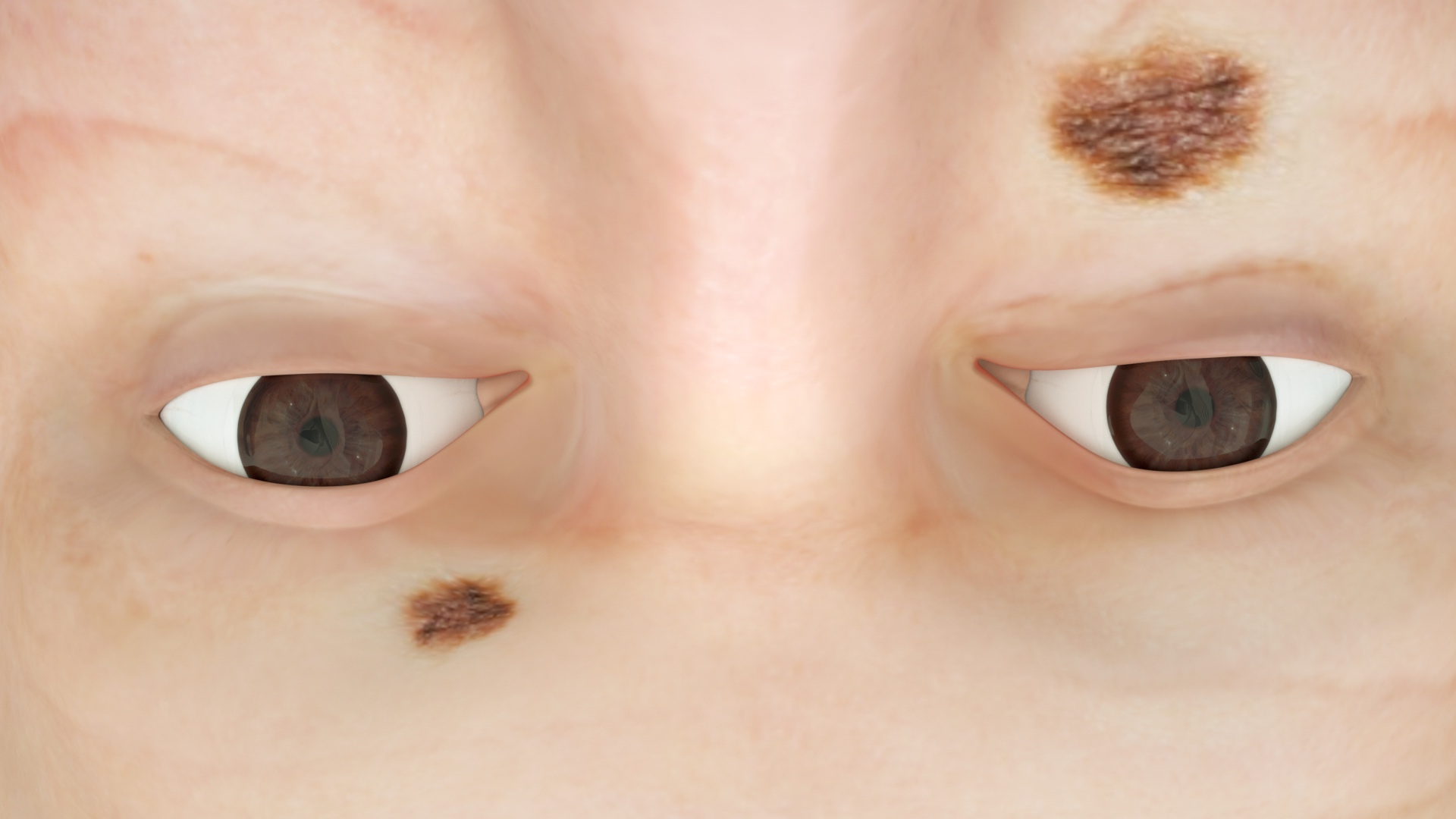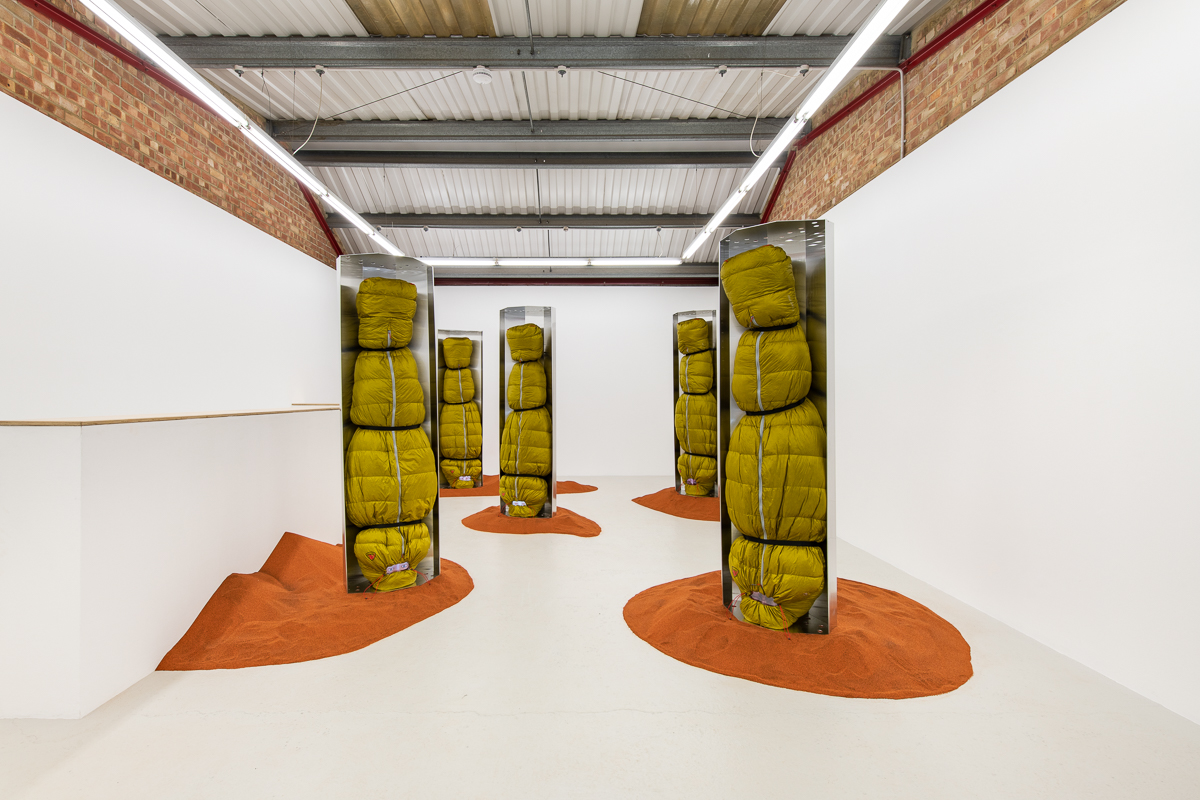
PRESS RELEASE INSTALLATION VIEWS ARTWORKS ARTIST INFORMATION
STINE DEJA
28 FEBRUARY — 18 APRIL 2020
OPENING RECEPTION
THURSDAY, 27 FEBRUARY, 6—8 PM
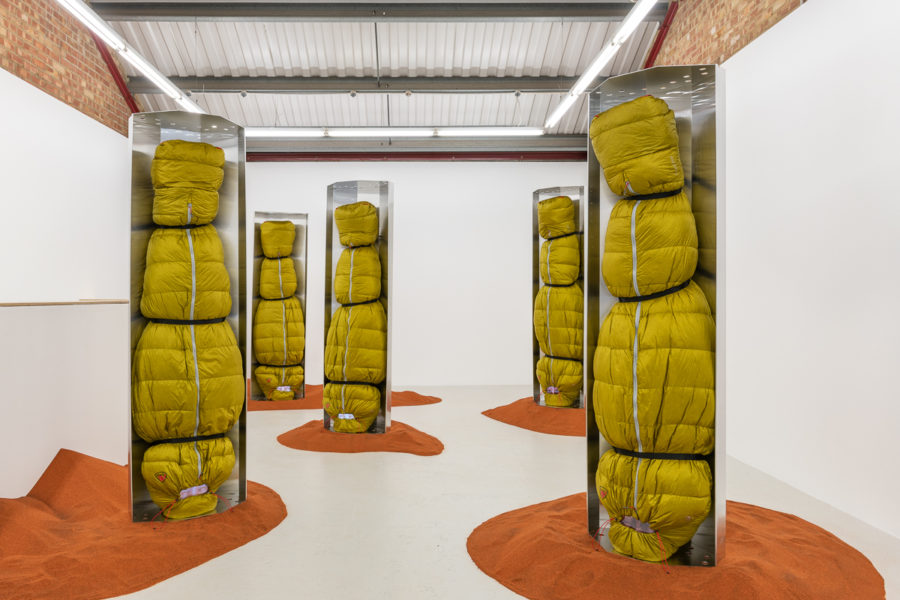
PRESS RELEASE
Press preview in presence of the artist Stine Deja : Thursday, 27 February, 5 PM
Annka Kultys Gallery is pleased to announce Stine Deja: Last Resort, an exhibition of a new series of sculptures from the London-based Danish artist’s latest research into immortality and life extending treatments. The show will feature five mixed-media sculptures of human bodies that have been cryogenically suspended in the hope that science will in the future evolve to a point where they can be successfully brought back to life.
Last Resort is part of Deja’s growing body of work exploring the larger themes of transhumanism and cryopreservation. Through the show, Deja explores the motivations and beliefs of the individuals buying into cryopreservation, whilst simultaneously investigating the social and ethical implications of its wider uptake.
Following extensive research on cryopreservation methods (cryopreservation is the process of cooling and storing cells, tissues or organs at very low temperatures to maintain their on-going viability), Deja has produced Thermal Womb, her latest series of sculptures derived from that research, the first works of which are on exhibition in the show. The series present a simulacrum of how one of the largest companies operating in the cryopreservation field, the Alcor Life Extension Foundation based in Arizona, USA, stores the bodies of people who have elected to be cryogenically preserved.
Alcor stores its bodies upside down in thermal sleeping bags immersed into metal dewars (specialist double-walled vacuum insulated storage spaces used to hold liquids well beneath ambient temperatures) which are filled with liquid nitrogen at minus 196 degrees Celsius. The bodies are stored upside down to keep the heads chilled for as long as possible in the unfortunate event an emergency occurs and the cooling system breaks down. Worldwide it is believed there are approximately 400 whole bodies, and even more heads, immersed in liquid nitrogen waiting for science to progress in order that they can be brought back to life at some indeterminate time in the future.
For example, Alcor presently has 149 members who are preserved either as whole bodies or heads or brains. The company charges $200,000 to preserve a body and $80,000 to preserve a head, plus not insignificant annual membership fees and surcharges. Upon the death of an Alcor member, Alcor will assume custody of the member’s body, rush it to Alcor’s Arizona storage facility via emergency ambulance, ensuring it gets enough oxygen and blood to stabilise itself during transportation until it reaches the facility, whereupon the body is placed in ice and injected with anti-coagulant before its temperature is slowly lowered over weeks to -196 degrees Celsius.
The intention is to restore and unfreeze the bodies once science creates the technology that enables that to happen. Yet at present the technology to restore a body from cryogenic suspension does not exist and some scientists argue the issues involved are so complex it never will, which in turn raises a myriad of ethical concerns. Is Alcor selling its members the false hope of a future resurrection that will never occur, in the same way snake oil salesmen duped the hapless when America’s west was truly wild? Should only the elite (or at least those able to afford $200,000 when they die) have access to the possibility of future resurrection? If the technology does evolve quickly and science enables humans to live forever in the very near term, e.g., 50, 100, 200 years from now, does it not seem desperately unlucky to be one of the last generations to be merely mortal? Should humanity blithely accept its ongoing mortality or optimistically hope for immortality in a new, possibly transhuman, future? What will be the unforeseen consequences of human populations not dying as they always have and the concomitant population explosion that would result from successful cryopreservation technology, particularly in the context of the planet’s global warming?
Yet are there reasons for hope? While cryogenics has been the subject of science fiction for over a century, in the realm of science fact, human cryopreservation is actually not such a new phenomenon; the doctor James Bedford became the first body frozen in cryogenic suspension in 1967. Moreover, viable cryopreservation already occurs in nature in animals like reptiles, amphibians and worms (with worms even remembering pre-freezing memories, i.e., pre-freezing brain functions are maintained). Today cryopreservation techniques are used successfully for organ preservation, lowering patients’ body temperatures to allow doctors to operate on aneurisms and for freezing human embryos. Cryopreserved and vitrified cells and tissues, for example, are used in human organ transplants for basic body parts like fingers and legs, while for certain mammals with considerable genetic similarities to humans, such as pigs or rabbits, major organs like kidneys, livers and lungs have been successfully cryopreserved, restored and transplanted back into host animals. Furthermore, new areas of research like nanotechnology (which involves the manipulation of individual atoms and molecules) is likely to make restoration much more viable than it is presently by enabling the repair of cells damaged during cryonic suspension at the cellular level. With science making such advances, is it wrong for proponents of cryopreservation, such as Alcor, to offer hope to those who aspire to immortality?
The works in Last Resort envision the gallery goer entering a future time where the bodies on display remain in cryogenic suspension, optimistically awaiting their revival. The show’s title ‘Last Resort’ is a pun on the phrase’s English colloquial meaning of a final course of action, used only when all else has failed, and the alternative meaning of a last or final holiday resort, represented by places like Alcor, where people go on their final, perhaps endless, vacation.
In the gallery space Deja has installed five human-size sculptures. They are presented suspended, head-down, on a floor covered with terracotta sand like that of the Arizona desert in which Alcor is located. Each of the five sculptures comprises an aluminium coffin-like structure, from which a gold sleeping bag is suspended upside-down via straps and filled in the shape of human body, the top of the body’s head just raised above the sand. The installation has been curated to create a small path through the sand inviting the viewer to navigate between the sculptures.
At first glance the sculptures all look identical, standing very still, not unlike soldiers at attention, and it takes a moment to notice that each has its own animated head at the bottom of its sleeping bag where the sculpture’s cryogenically suspended body’s face would be. The video gives each sculpture a unique animated face, which acts as a kind of portrait panel for the sculpture, not unlike the elaborately painted death masks of Ancient Egypt that were affixed to the mummified bodies of Egyptian royalty during their mummification process. The ancient Egyptians believed that the painted masks would help a dead person’s soul (or Ka) recognise its owner in the afterlife – a conundrum that future unfrozen cryopreserved humans may also have to contend with.
The human quest for eternal life is of course a timeless pursuit: the ancient Mesopotamian poem, The Epic of Gilgamesh (c. 2,100 BC) tells the tale of the title character’s search for his own immortality; the Egyptians famous proclivity for mummification to preserve their elite’s bodies for use in the afterlife has been touched upon already; while through antiquity and the middle ages the ultimate goal for alchemists was the philosopher’s stone (also known as the elixir of youth) a potion that would supposedly grant its drinker eternal youth. In the early part of the twentieth century, in 1920s’ America for example, it was fashionable for men to go through a xenotransplantation (the macabre process of grafting or transplanting organs or tissues between members of different species) and have goat or monkey testicles inserted into their own, in the hope of boosting their own sex drive and revisiting the virility of youth. And today a start-up called Ambrosia harvests ‘young blood’ in order to perform transfusions of human plasma. In such as context, cryopreservation may be viewed as just another iteration of man’s never-ending quest for immortality.
Indeed futurists working for Google believe that we may now be little more than a decade away from taking major steps towards making immortality a genuine possibility for humankind. It is therefore something every one of us may need to actively consider in the very near future, along with all the ethical complications that accompany the possibility. Most pressingly, will we even be human if it is?
Last Resort is the fourth solo presentation of Stine Deja’s work with the gallery.
SELECTED PRESS
Stine Deja: Last Resort
INSTALLATION VIEWS
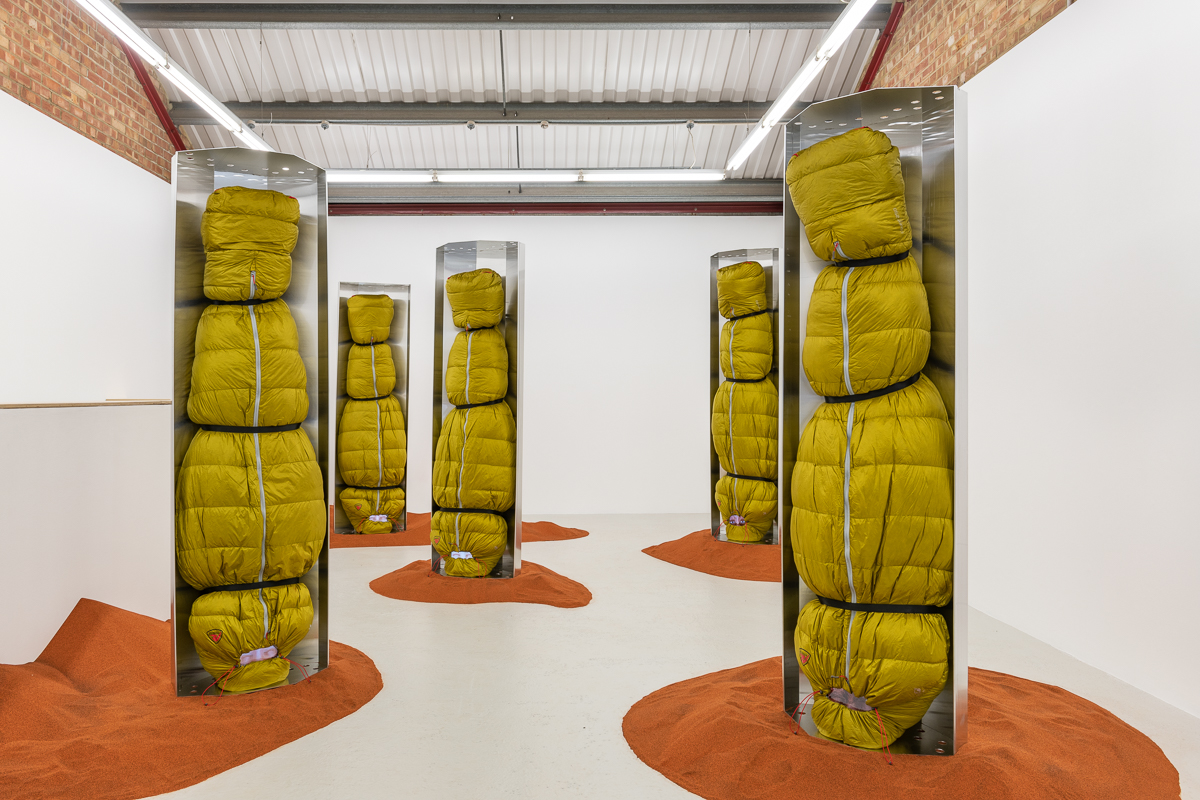
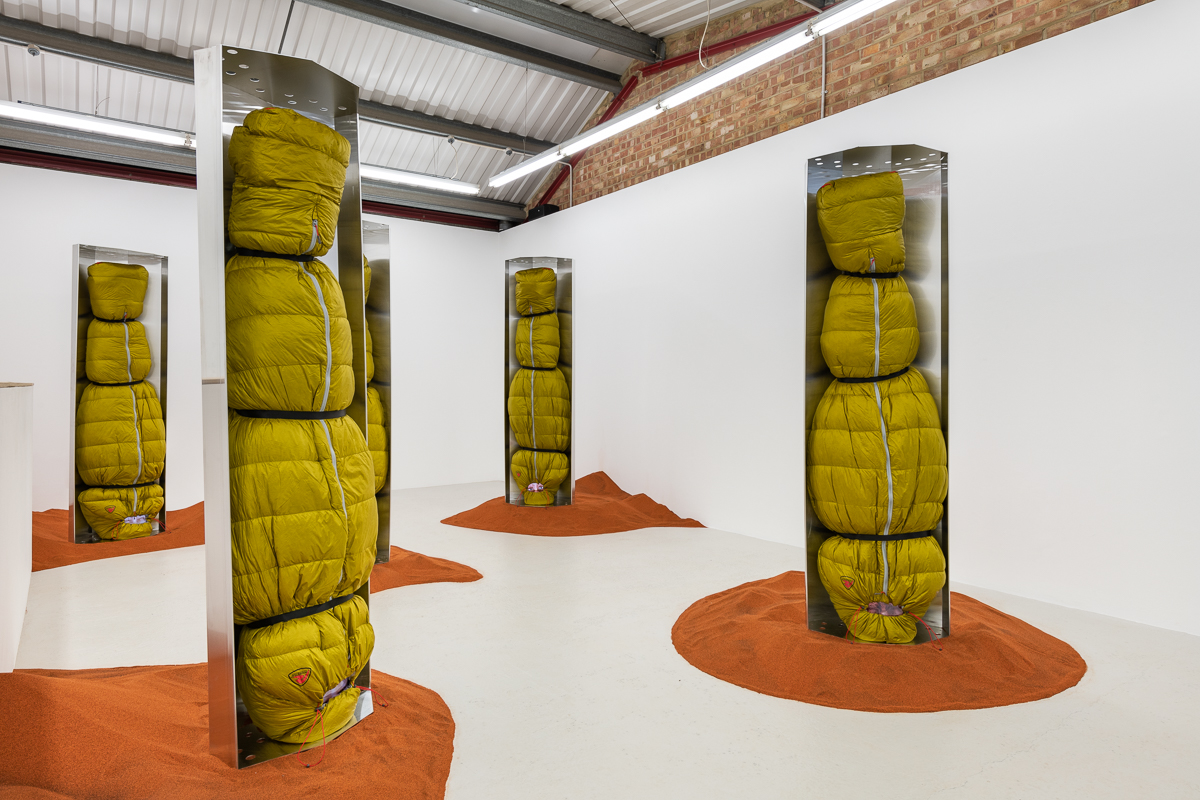
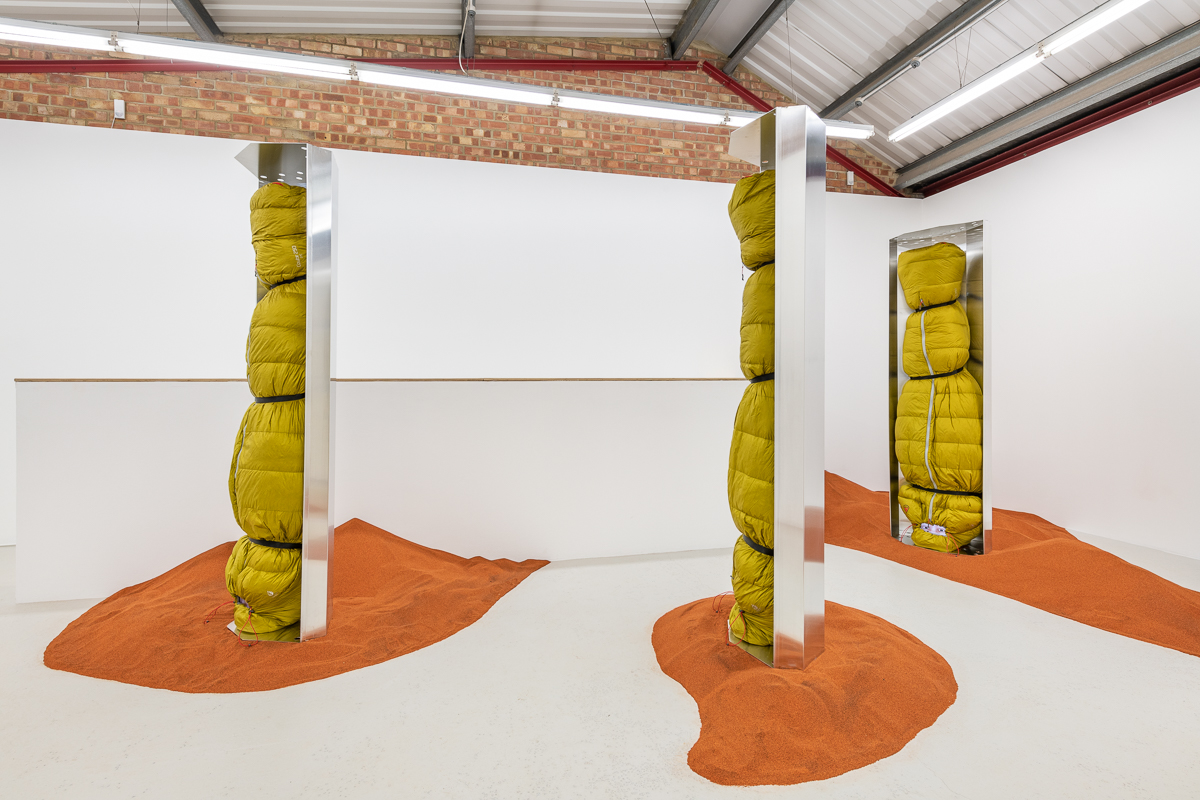
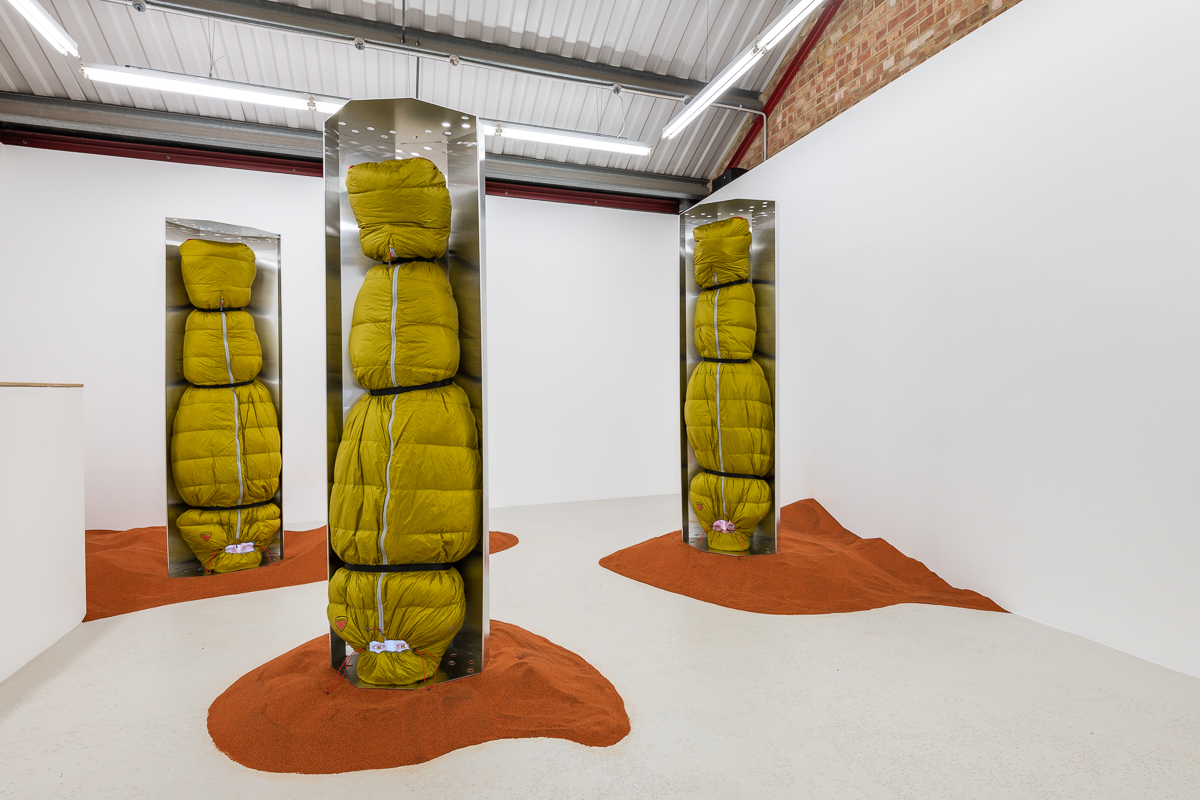
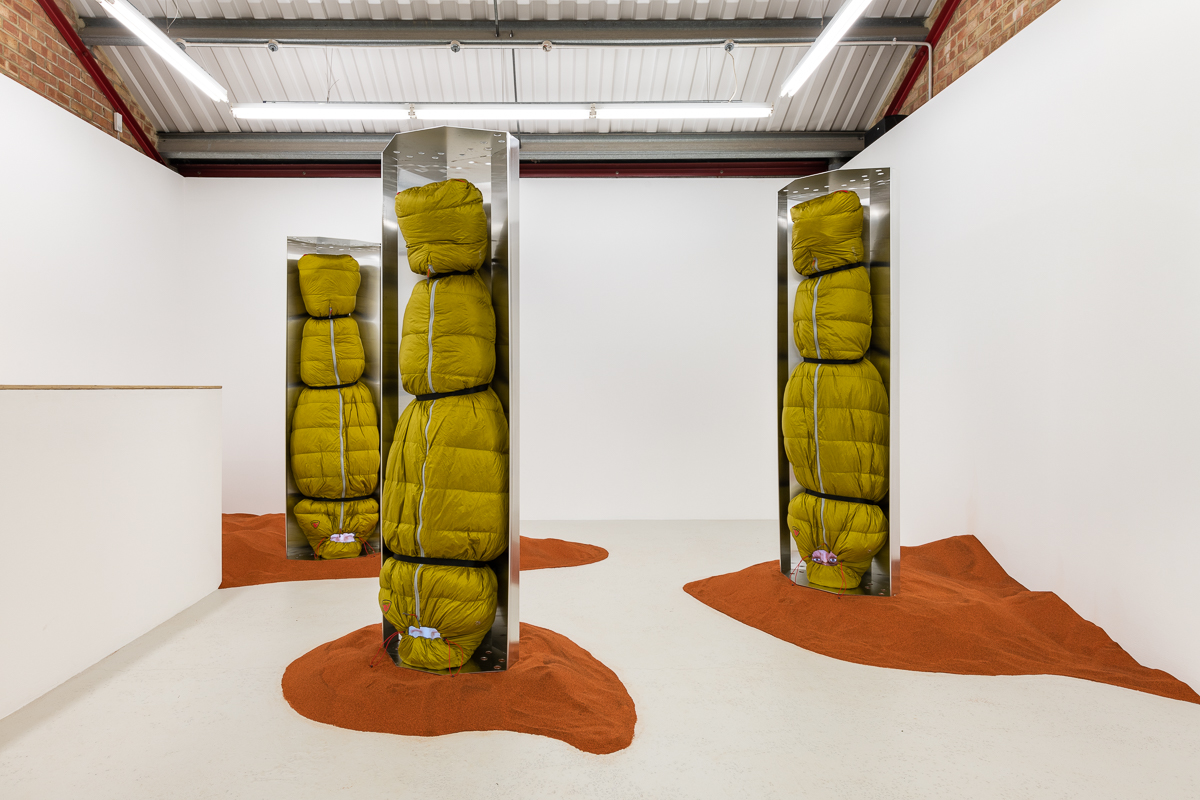
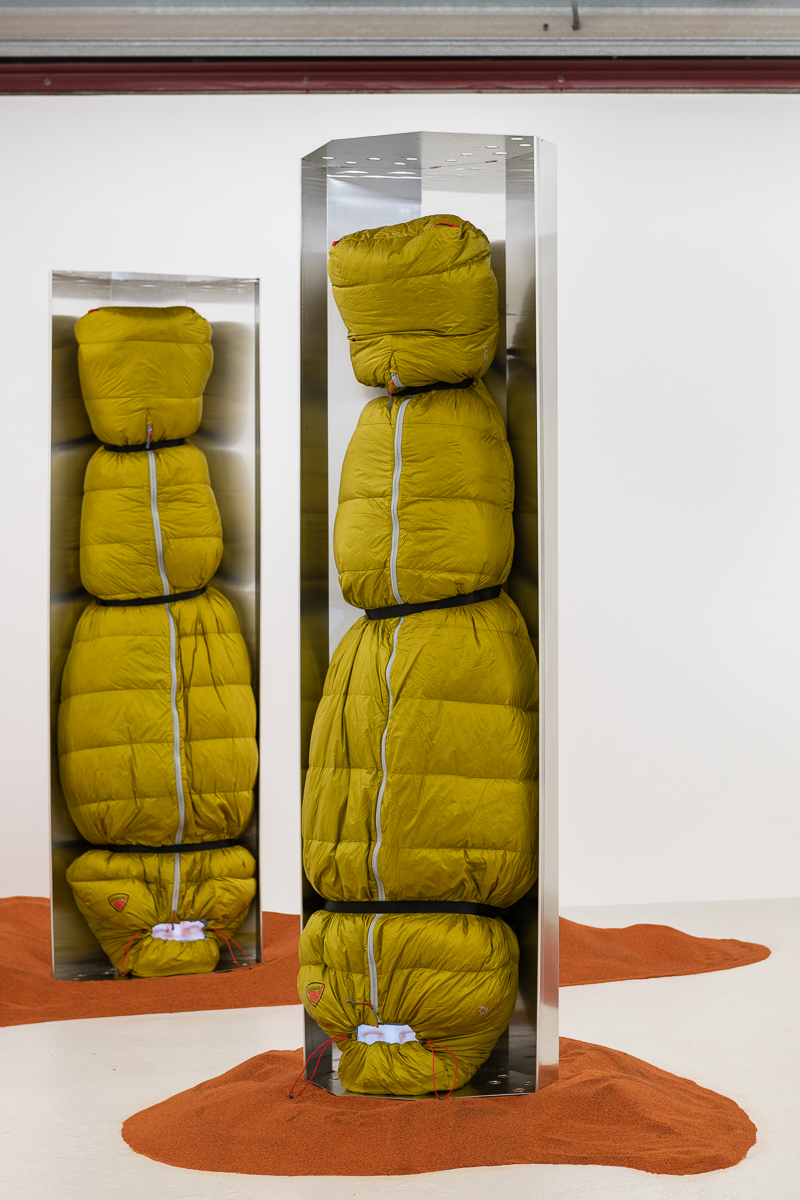
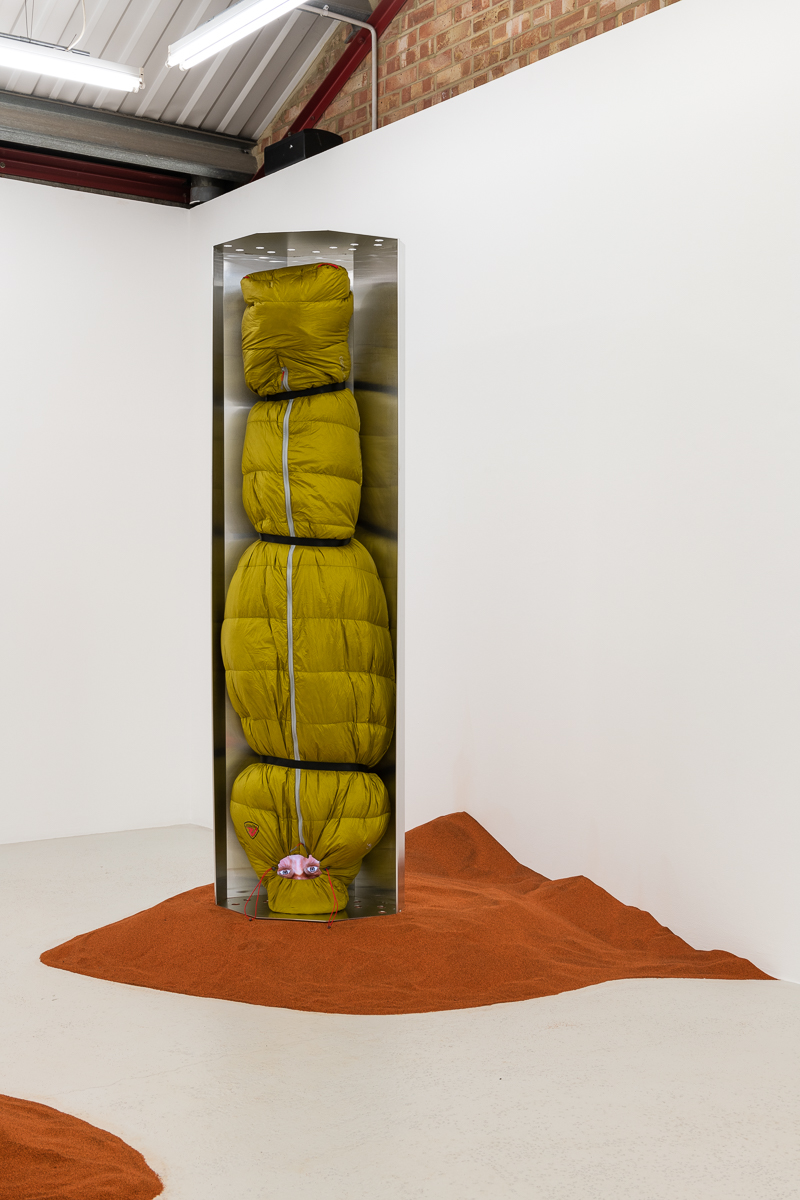
ARTWORKS
Each sculpture’s face is created by placing an iPad within the sleeping bag that displays subtle eye movements using video created by Deja. Up close the visitor can discern that a different person is presented in each sculpture, notwithstanding that most of the face, including the mouth and nose, is covered by the sleeping bag, as the body’s eyes and the skin surrounding the eyes, plus the eyelids, eyelashes and brows, arguably some of the most personal parts of the body, reveal clues about the identity of the otherwise anonymous frozen body.
The first sculpture in the show, entitled Thermal Womb: 22.07.1998 (2019-2020) portrays a man with stereotypically English blonde eyebrows, his translucent blue eyes exhibiting slight discoloration from being blood shot.
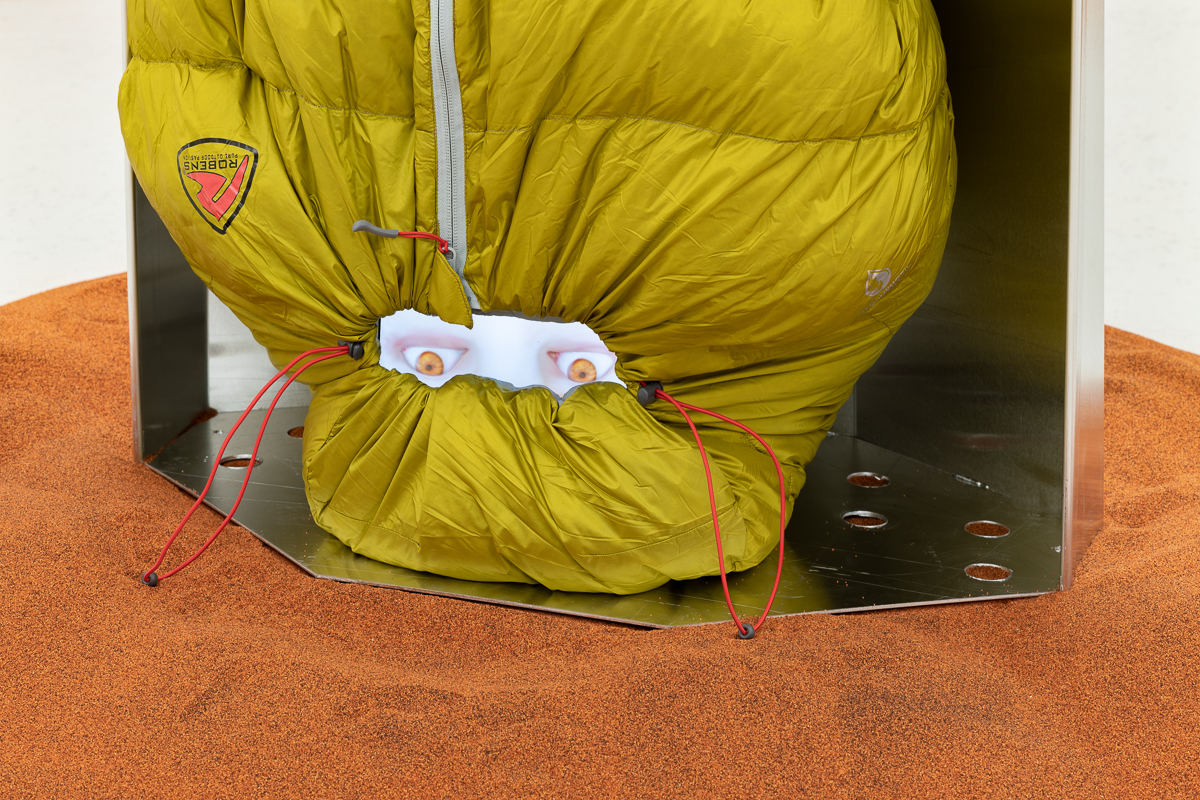
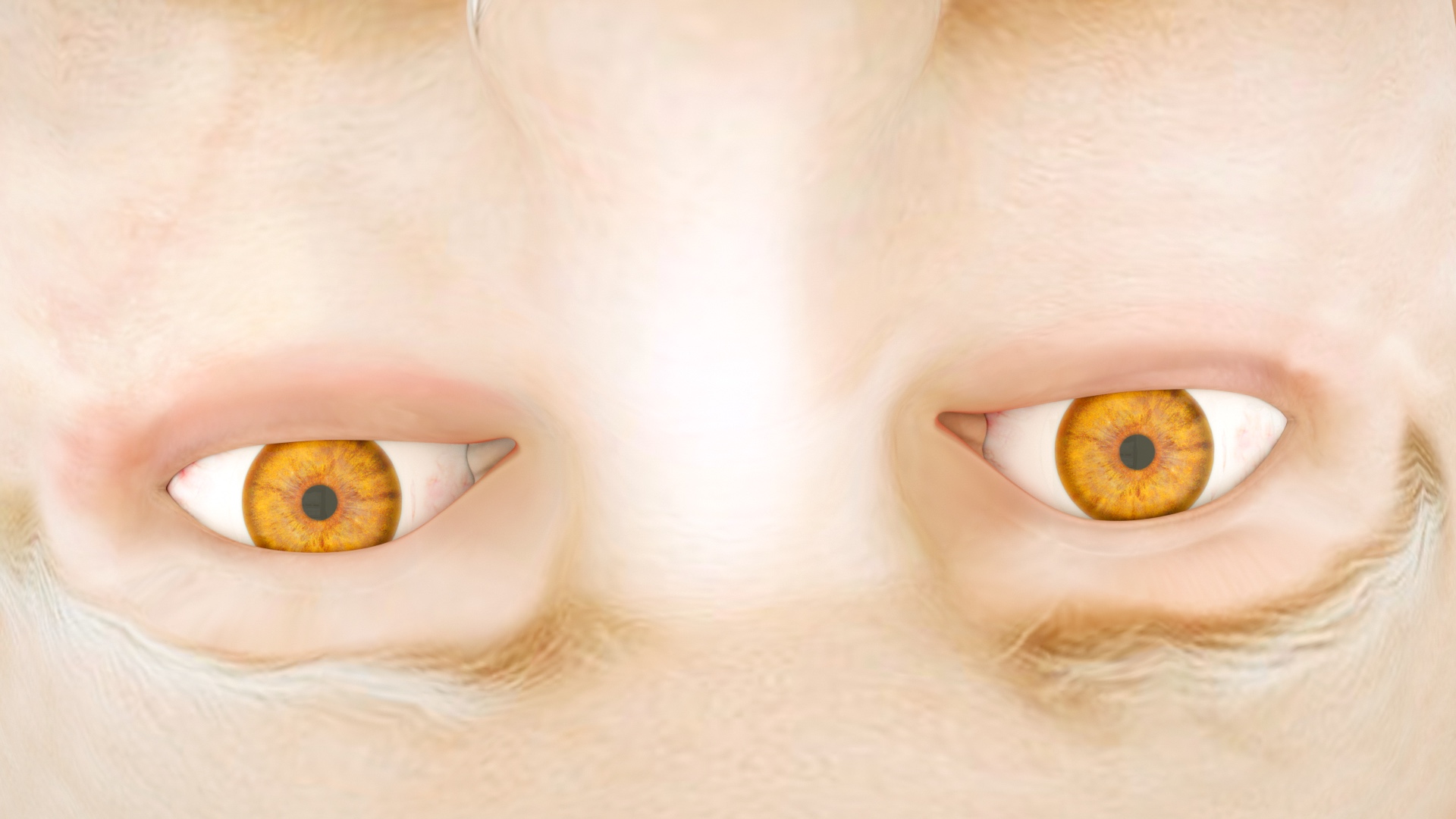
Thermal Womb: 22.07.1998
2019-2020
Aluminium, sleeping bag and filing, ratchet straps, and tablet with looping video
200 x 55 x 45 cm (78 3/4 x 21 5/8 x 17 7/8 in)
Unique
(SDej014.20)
A younger face appears in Thermal Womb: 08.08.2010 (2019), showing a white male in his thirties with unusually hairy eyebrows, grey green eyes with a dark circles and almost adolescent spots on his face.
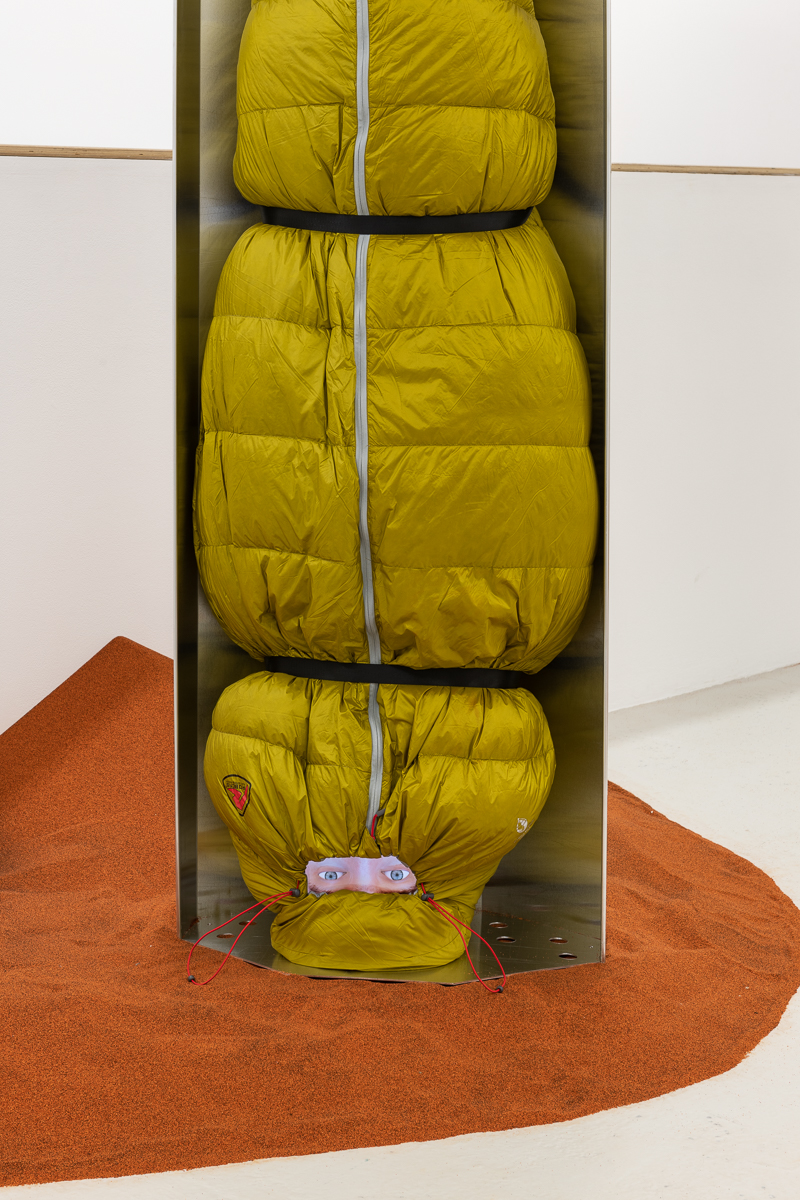
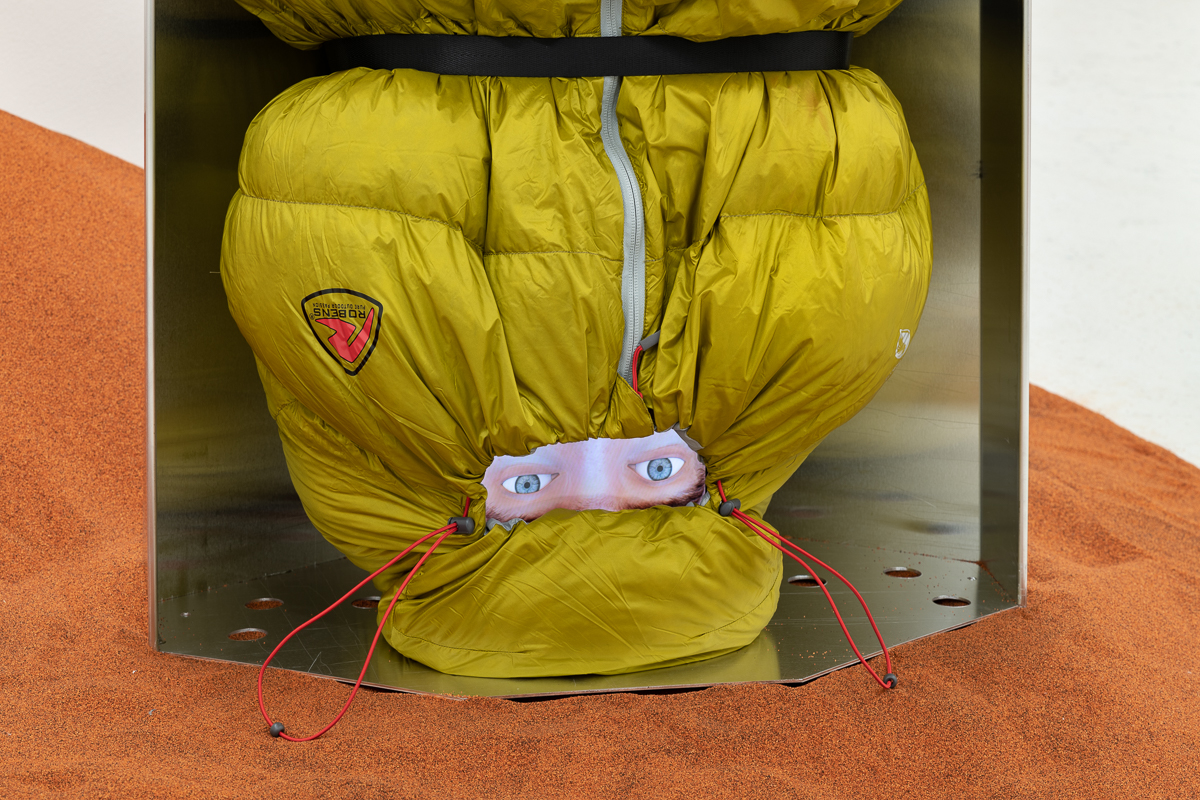
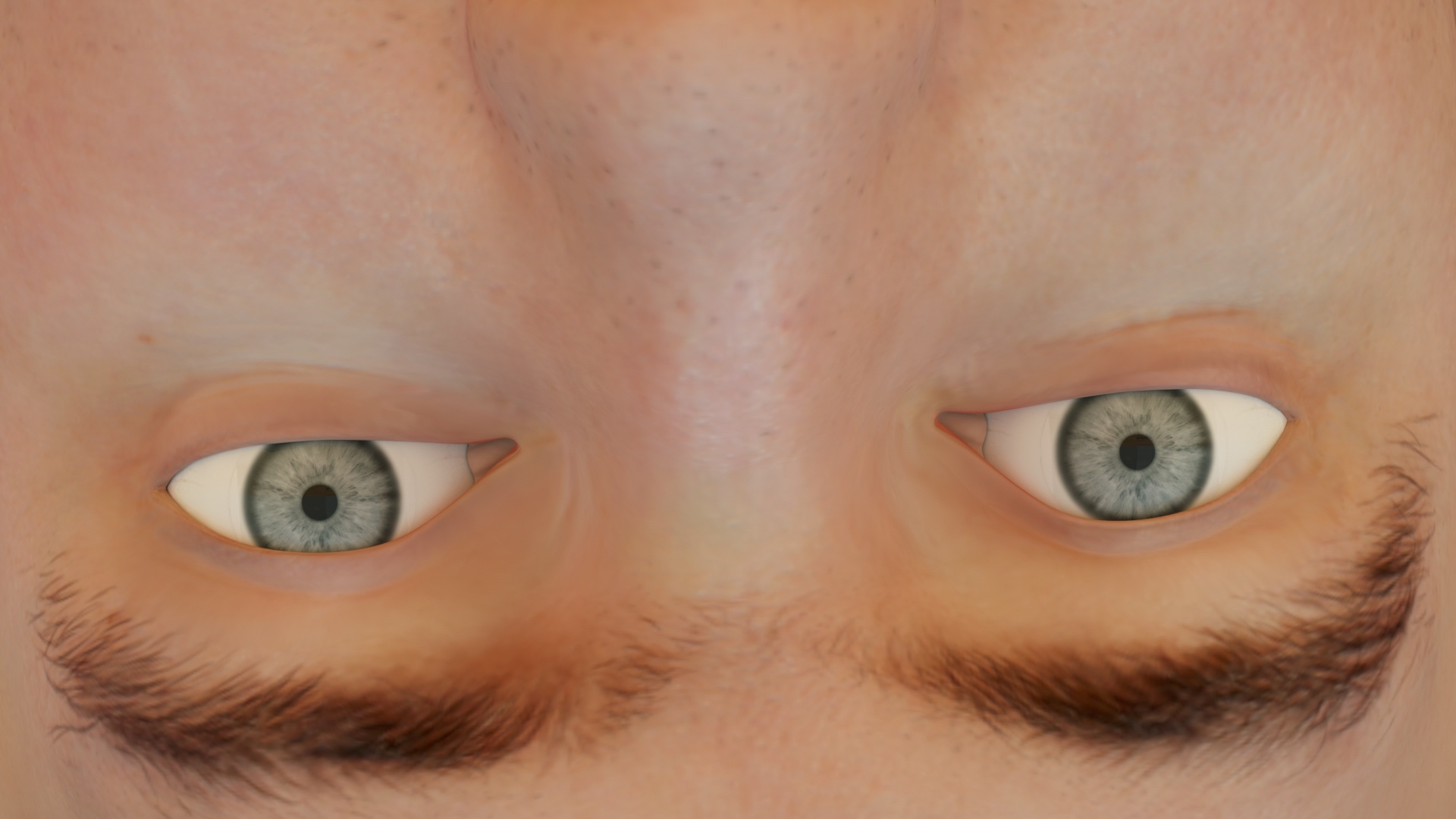
Thermal Womb: 08.08.2010
2019
Aluminium, sleeping bag and filing, ratchet straps, and tablet with looping video
200 x 55 x 45 cm (78 3/4 x 21 5/8 x 17 7/8 in)
Unique
(SDej017.19)
By contrast, Thermal Womb: 12.05.2003 (2019-2020) shows a woman with well-groomed eyebrows and freckled skin. Her skin is light brown with the freckles adding darker pigmentation, while her eyebrows appear raised as if she is surprised to be there, above her light grey eyes.
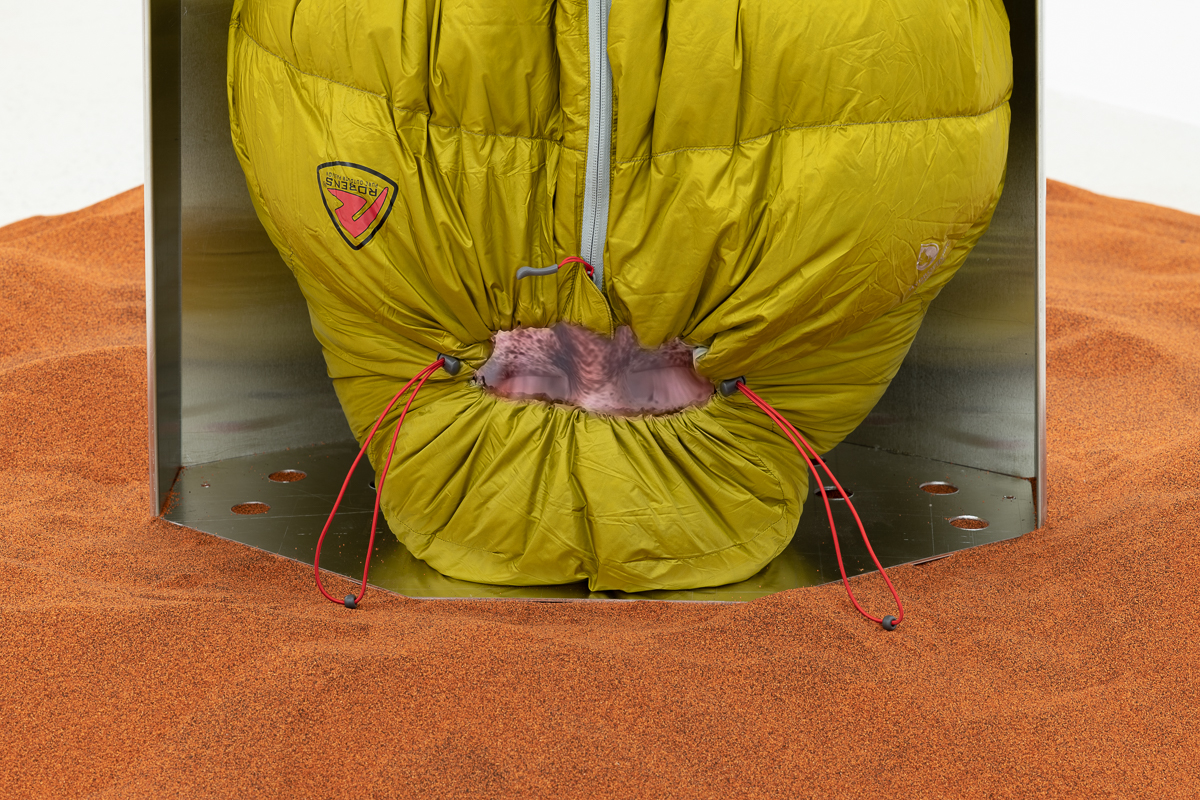
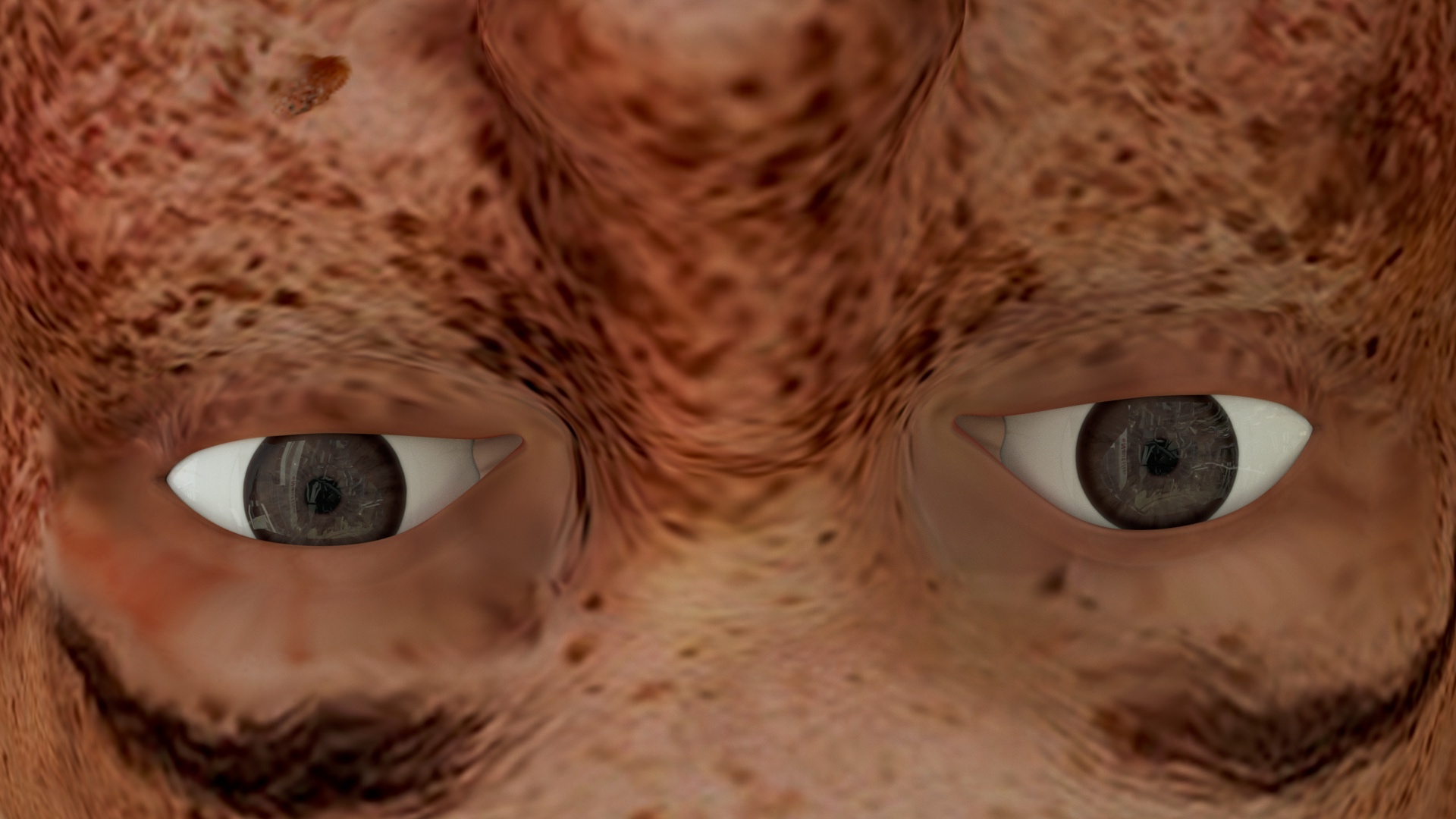
Thermal Womb: 12.05.2003
2019-2020
Aluminium, sleeping bag and filing, ratchet straps, and tablet with looping video
200 x 55 x 45 cm (78 3/4 x 21 5/8 x 17 7/8 in)
Unique
(SDej015.20)
Thermal Womb: 03.04.2007 (2019-2020) portrays an elderly man with two large liver spots, possibly even resembling melanomas. Although his skin looks smooth, his advanced age can be recognised through the liver spots, the lack of eyebrows, the wrinkles on his nose and the dark umber colour of his eyes.
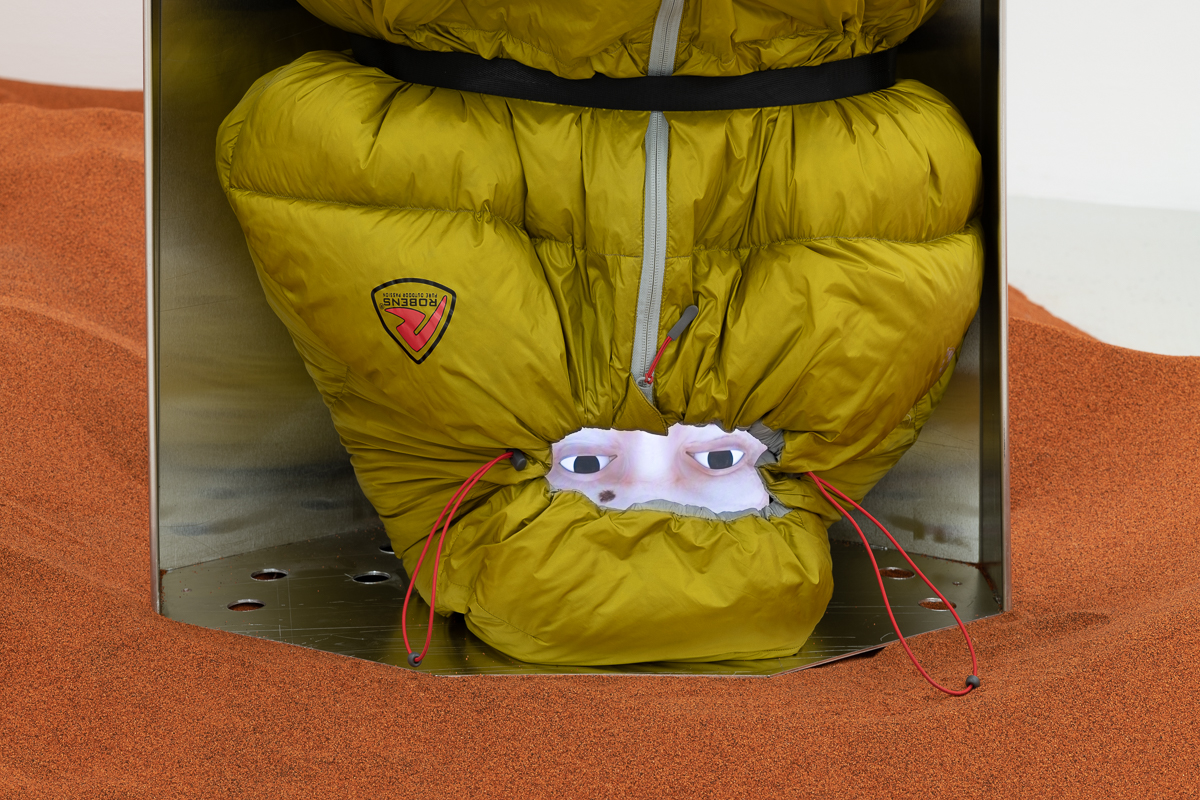
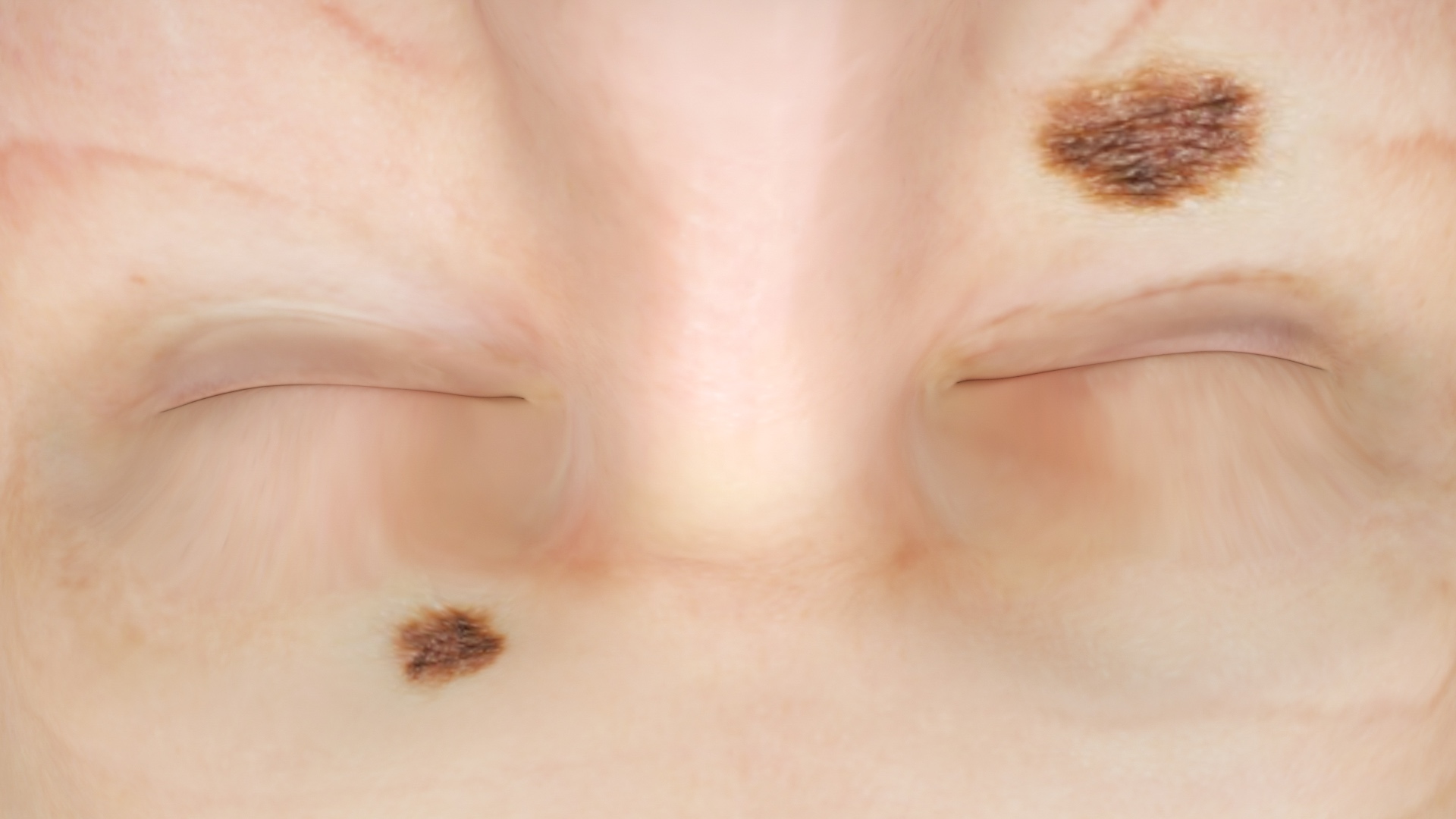
Thermal Womb: 03.04.2007
2019 – 2020
Aluminium, sleeping bag and filing, ratchet straps, and tablet with looping video
200 x 55 x 45 cm (78 3/4 x 21 5/8 x 17 7/8 in)
Unique
(SDej016.20)
Thermal Womb: 07.04.2016 face is notable for a red tattoo of the word ‘stay’ appearing just below the eye on the right cheek; the red colour of the tattoo resembling the red of blood vessels in the bags under the eyes.
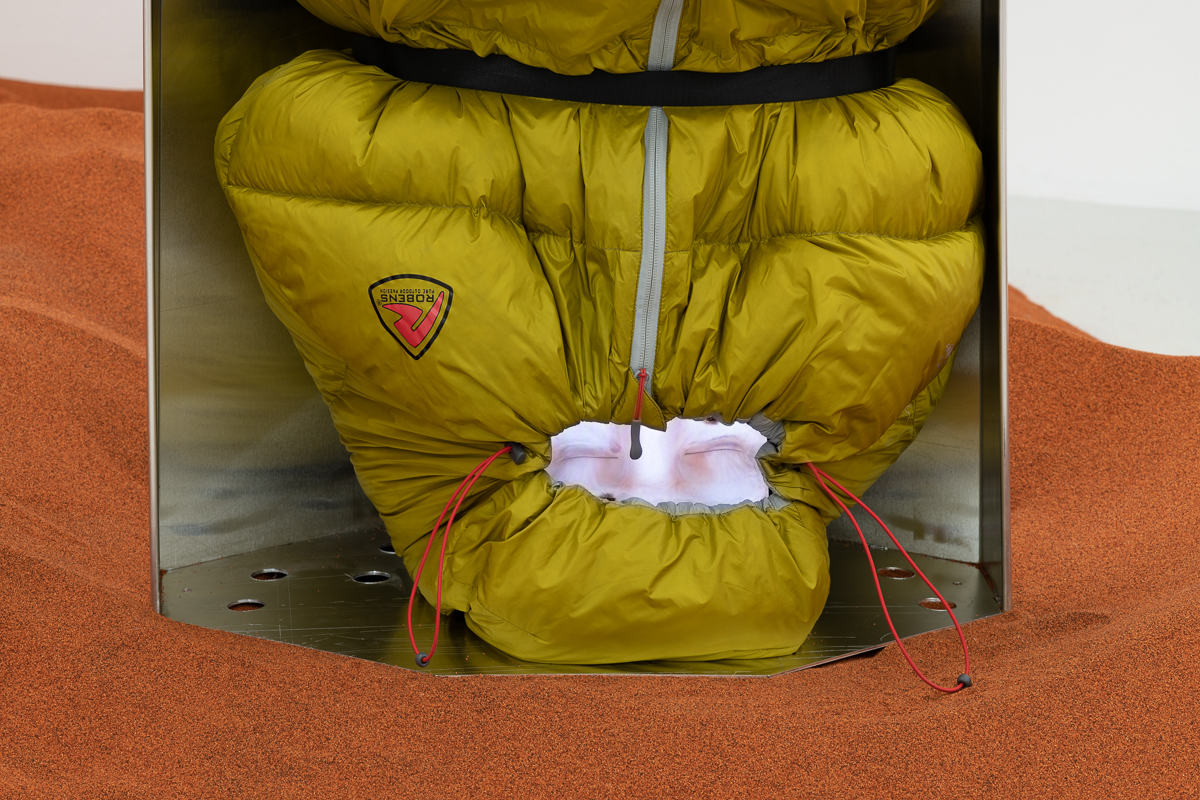
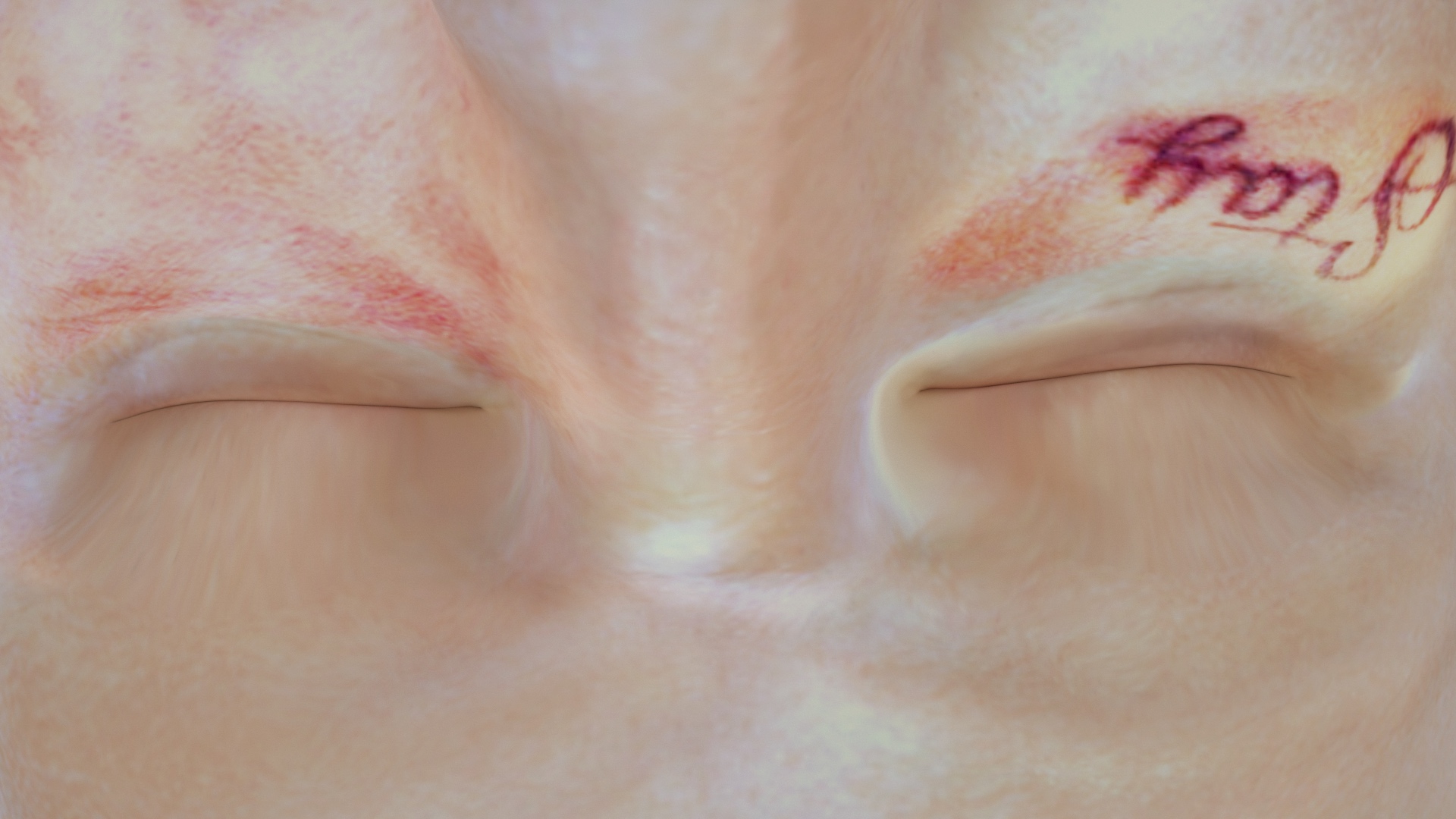
Thermal Womb: 07.04.2016
2019 – 2020
Aluminium, sleeping bag and filing, ratchet straps, and tablet with looping video
200 x 55 x 45 cm (78 3/4 x 21 5/8 x 17 7/8 in)
Unique
(SDej018.20)
The final sculpture is Thermal Womb: 27.09.2019 (2019-2020), and portrays another male, but unlike the other sculptures, the face portrayed in Thermal Womb: 27.09.2019 does not look straight out at the viewer and instead the brown eyes look away.
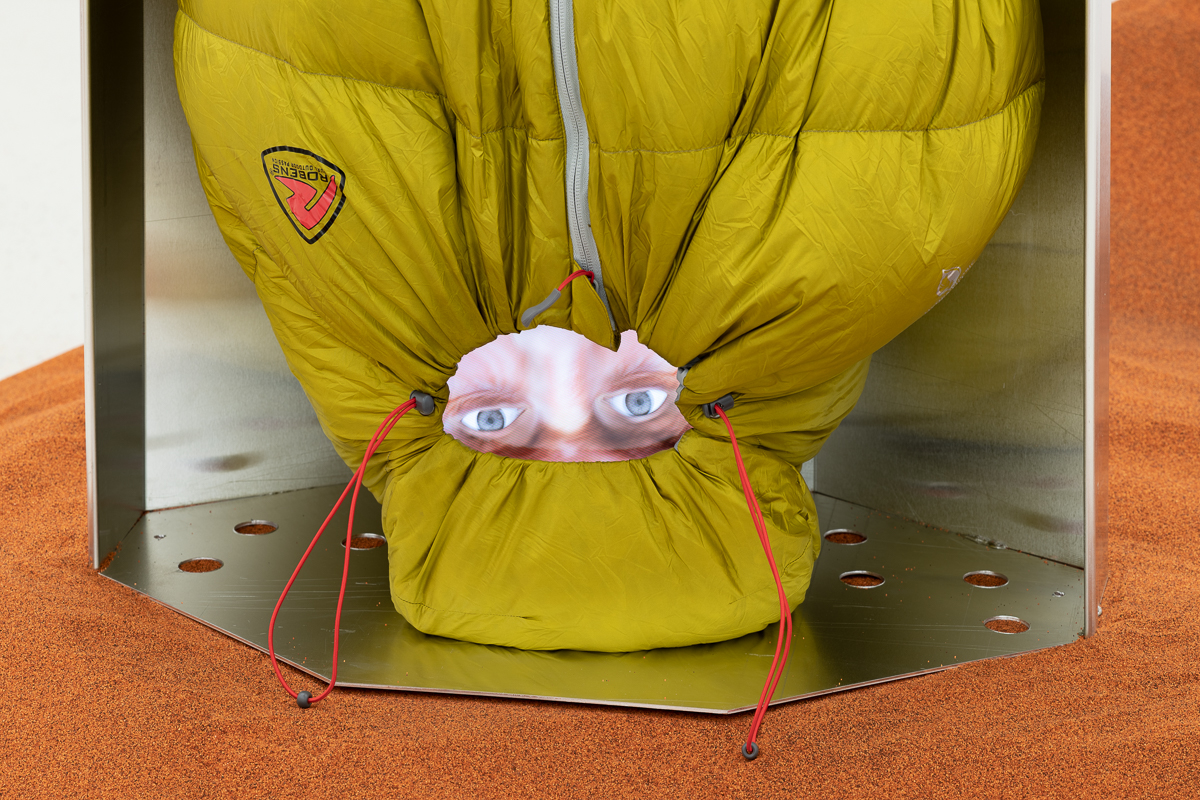
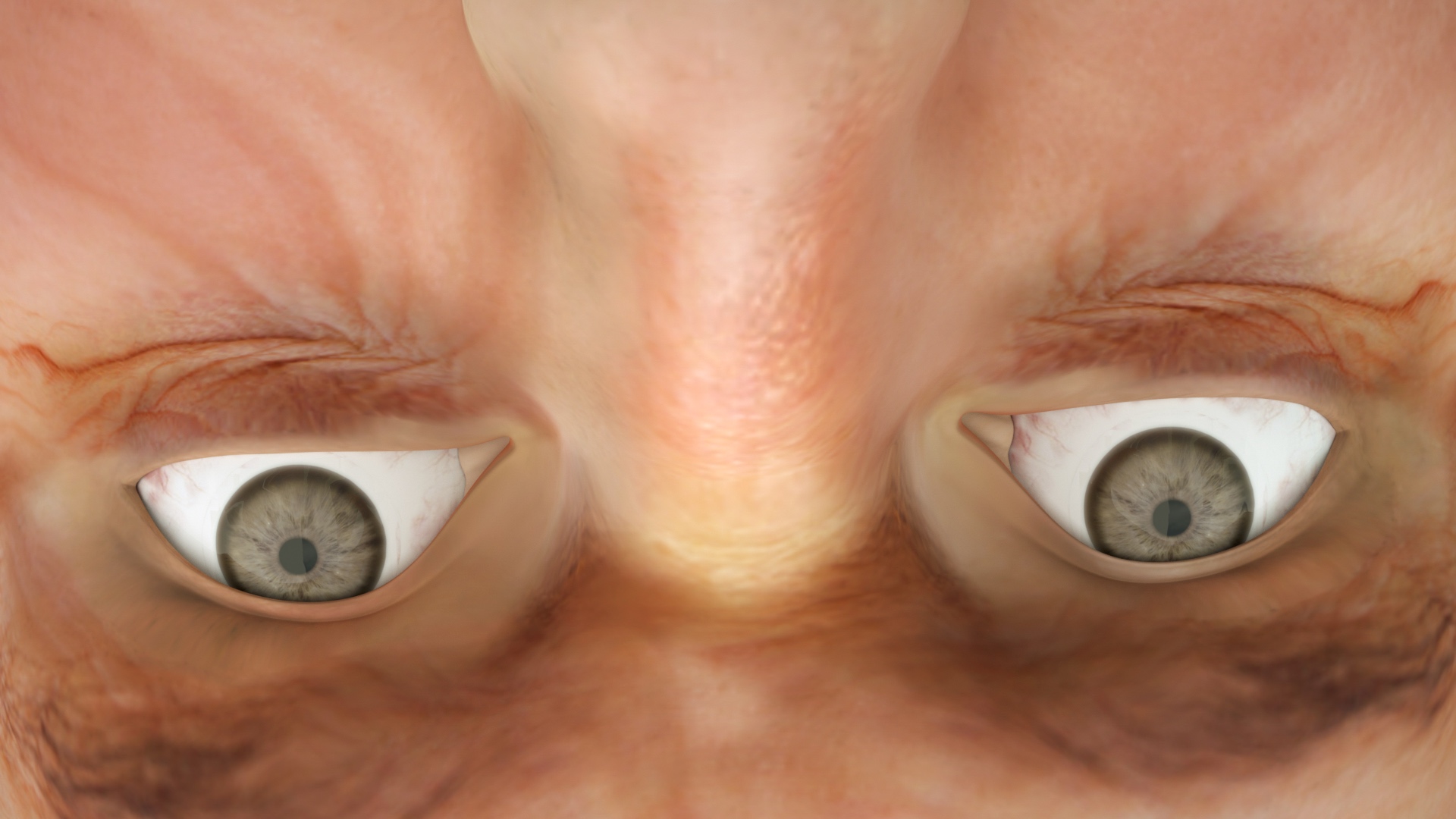
Thermal Womb: 27.09.2019
2019 – 2020
Aluminium, sleeping bag and filing, ratchet straps, and tablet with looping video
200 x 55 x 45 cm (78 3/4 x 21 5/8 x 17 7/8 in)
Unique
(SDej019.20)
ARTIST INFORMATION
Stine Deja was born in 1986 in Denmark. She currently lives and works in Copenhagen.

